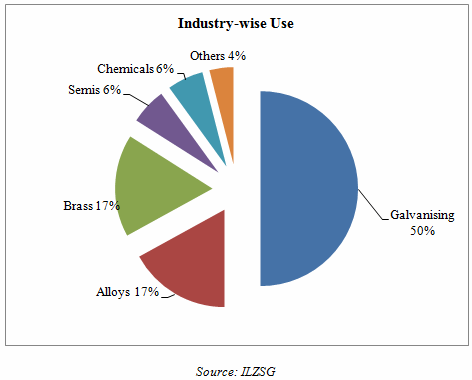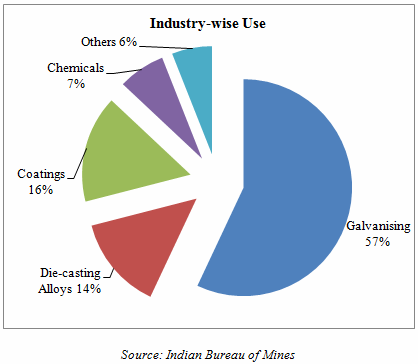|
|
Zinc |
||||||||||||||||||||||||||||||||||||||||||||||||||||||||||||||||||||||||||||||||||||||||||||||||||||||||||||||
| 24 December 2014 02:09 PM | ||||||||||||||||||||||||||||||||||||||||||||||||||||||||||||||||||||||||||||||||||||||||||||||||||||||||||||||
|
Zinc is metallic mineral known since historic times. It is the fourth most used metal after iron, aluminium and copper. The use of zinc in making along with copper reported to have made in ancient roman times. However, India is reported to be first country to recognize the zinc as a metal.
Historians suggested that zinc was produced large sale in India as early as in 12th century. Further, historical evidence indicated that the zinc production in Zawar, Rajasthan dates back to 9th century. It was rediscovered in Europe in 16th century. It has got the name after German word ‘zinke’. In India zinc is commonly known as Jasta, Jast, Naag in Hindi.
Zinc is a hard bluish-white lustrous metal and becomes soft between 100 to 150o C. It is present not only in earth’s crust but also in water and living organisms including humans. Zinc deficiency causes many diseases in plants, animals and human beings.
Important Uses:
Zinc is a metallic chemical with a wide range of uses. It is largely used for galvanizing iron to protect from corrosion.
Other important applications of zinc are alloys for die casting industry and brass, rolled zinc applications and consumption in the chemical form (fertilizers and mineral supplements).
Mineral Sources:
Zinc is present in a number of ores and most common types are sulfides, carbonates, silicates and oxides. According to the Geological Survey of India, the most significant mineral ores are zinc sulphide or sphalerite, zinc carbonate or smithsonite, zinc silicate or willemite and zinc oxide or zincite. Sphalerite is the most important ore and contains about 64.06% of zinc.
Production: The ores contain 1-15% of zinc and once it is concentrated after grinding and floatation it contains about 55% zinc. The process begins with roasting of the concentrate at a temperature of 950°C and oxidization of zinc, iron and sulphur occurs. Once sulphur dioxide is separated, iron and zinc oxides are leached with dilute sulphuric acid.
The refined solution is electrolyzed with lead anode and aluminum cathode. After the cathode is immersed in the solution for 48 hours, zinc is deposited on the cathode. Zinc thus stripped from cathode forms as a metal with 99.95% purity.
Mine production accounts for about 70% and the rest of the 30% come from recycling of secondary sources. Secondary sources are alloys.
World Scenario
World zinc reserves are estimated at 250 million tons. Australia has the largest share of about 28% of world reserves, followed by China with 17%, Peru with 7.1%, Mexico with 6.4%, India with 4.8% and U.S. with 4.4% as per the data released by the US Geological Survey (USGS).
Mine production of zinc is increasing steadily at an average annual growth rate of about 3.3% per annum during the period 2007 to 2012. However, according to the estimates of International Lead and Zinc Study Group, zinc mine production has increased only at about 2.6% per annum in the corresponding period. Further, zinc metal production has increased only at about 2% per annum during 2007 to 2012.
Table 1: World zinc mine production (1000 tons)
Source: USGS
Among various countries produced, China occupies the first place in case of mine production accounting for about 34% and 40% in terms of metal production. Australia takes the second place with about 12% of mine production followed by Peru with 10%, U.S. with 6% and India with 5.5% share in total mine production in the world.
 Use of refined zinc is estimated at about 12.3 million tons as per the latest data available with the ILZSG. Pattern of consumption and production of zinc metal suggests that they are in tune with each other and there appears to be a surplus in the all the years despite a fall in output. Use of zinc is the highest in Asian countries particularly in China. Europe followed by U.S., Japan and Korea.
Industry-wise use of zinc indicated that galvanizing industry is the largest consumer accounting for about 50% of total zinc in the world followed by alloys, Brass, semis and chemical industries.
Table 2: Trends in world production and use of zinc metal (000 tons)
Source: International Lead and Zinc Study Group (ILZSG)
Domestic Scenario
Zinc production in India is sufficient to meet domestic consumption requirements and is in fact surplus. India is the 5th largest producer of zinc and is the 6th largest in reserves position in the world. Zinc mine production in India is primarily concentrated in Rajasthan state.
Primary zinc is produced mainly by Hindusthan Zinc Ltd and Binani Zinc Ltd. HZL is the only producer of primary zinc and integrated producer of lead from the mines situated in Rajasthan. Binani Zinc Ltd produces zinc from imported concentrates.
Table 3: Trends in zinc production in India (tons)
Source: USGS
Total zinc content in resources is 36.66 million tons while in terms of reserves 12.45 million tons of zinc is available in the country. According to the estimates of IBM, Rajasthan is endowed with the largest resources of lead-zinc ore amounting to 88.6%, followed by Andhra Pradesh with 3.3%, Madhya Pradesh with 2.2%, Bihar with 1.7% and Maharashtra with 1.4% of share in total ore in the country.
Recycling of zinc is much smaller compared to other metals as zinc used for galvanizing and brass making cannot be recovered. In India, there are about 170 units with a zinc recycling capacity of 4.05 lakh tons per year.
Zinc can be substituted to some extent in the die-casting applications by aluminium, magnesium and plastic. Even in galvanizing industry, zinc can be substituted by ceramic and plastic coatings, electroplated cadmium and aluminium etc.,
 Consumption of zinc is estimated at around 5 to 5.5 lakh tons per annum on average during 2009 to 2011. Major industrial sectors using zinc in India are galvanizing with 57% share followed by coatings with 16%, alloys with 14% % and chemicals with 7% share in the total use.
Major Markets
Spot markets: Mumbai, Delhi
Futures markets:
International: LME, Comex and SHFE.
Domestic: MCX and NMCE.
External Trade
India has surplus position in zinc and exports on an average about 5 lakh tons both in the form of concentrates and finished products. However, India also imports about 1 to 2 lakh tons of zinc mainly in the form of ore & concentrates.
Major export destinations: China and South Korea for ore & concentrates Belgium, China, Italy, Turkey and UAE for zinc metal/slabs.
Major import sources: Australia and Peru for ore & concentrates. Australia, China, Iran, South Korea and Uzbekistan for zinc metal/slabs.
Factors Influencing Prices:
· Largely governed by the international markets and their price trends.
· Global economic conditions and macro-economic indicators.
· Geopolitical conditions of the major producing countries.
· Growth and performance of major utilizing industries.
· Government policies on trade both direct (restrictions) and indirect (taxes).
|
Copyright © CC Commodity Info Services LLP. All rights reserved.

